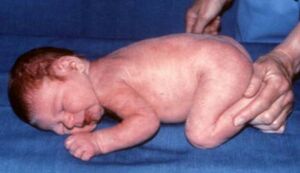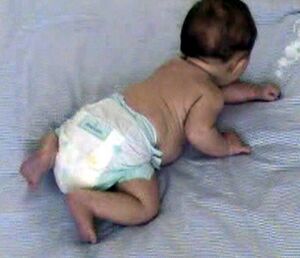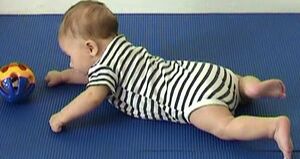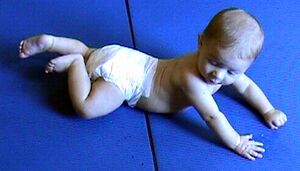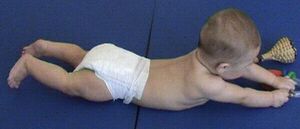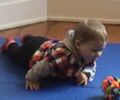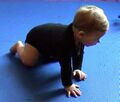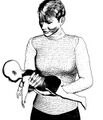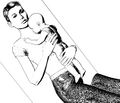Infant Development in Prone
Top Contributors - Stacy Schiurring and Jess Bell
Introduction[edit | edit source]
Many families feel insecure and unsure about placing their infant in prone (i.e. tummy time). These feelings can stem from fear and confusion about the benefits of wakeful tummy time.[1] It is essential, therefore, that rehabilitation professionals understand the benefits and clinical reasoning behind supervised wakeful prone positioning on the physical, cognitive, and social development of typically developing infants.
This article overviews the development in prone of infants from birth to crawling.
Birth to Three Months[edit | edit source]
Phase indicator: when infants are placed in prone, they learn to lift their heads in a sustained manner.
All images have been provided by and used with kind permission from Pam Versfeld, Physiotherapist.
Special Topic: Back-to-Sleep Campaign[edit | edit source]
While the developmental benefits of prone positioning are widely supported by research, prone positioning is not recommended during sleep.
Sudden Infant Death Syndrome (SIDS) is defined as the “sudden death of an infant under one year of age which remains unexplained after a thorough case investigation, including performance of a complete autopsy, examination of the death scene, and review of the clinical history.”[2] Research has shown a dramatic decrease in the incidence of SIDS worldwide with the introduction of the Back-to-Sleep campaign.[3]
One of the hallmark recommendations of the American Academy of Pediatrics’s (AAP) Back-to-Sleep campaign recommends infants be placed in a supine position for every sleep by every caregiver until the child reaches one year of age to reduce the risk of sleep-related death.[4] To learn more about the AAP’s other recommendations please read this article.
Three to Seven Months[edit | edit source]
Phase indicator: When infants are placed in prone, they are able to take some weight through their hands and upper extremities to reach forward and play with toys.
- Starting around four months, infants begin to find different ways to roll from supine to prone.
- During the four- to six-month period, the infant will become more mobile in the prone position.
All images have been provided by and used with kind permission from Pam Versfeld, Physiotherapist.
- Prone pivot: infants gain more control of lateral weight shift over the upper limbs. They start to pivot in place as they reach for toys that are out of reach.
- Prop sidelying/sitting: the infant takes weight on one shoulder, forearm, and one lower limb. This position requires good weight-bearing shoulder stability and the ability to right the head to one side, side flex the trunk, and dissociate the lower limbs with one hip in more extension or flexion than the other.
- Creeping (commando crawling, belly crawling): infants will often adopt an asymmetrical commando crawl pattern, pulling forward with one hand and pushing back with the other.
- Crawling:
- Immature reciprocal crawling: when infants first learn to crawl, they do so with hips and shoulders abducted and the lumbar spine in lordosis.
- Mature reciprocal crawling: the knees are aligned below the hips in neutral rotation, and the elbows are aligned below the shoulders. The lumbar spine is flat.
- Prone kneeling:
- Reaching in prone kneeling: as an infant's balance in prone kneeling improves, they start to reach for toys. To do this, the infant needs to rotate the shoulder girdle back away from the reaching hand. To make the position more stable, the infant may shift the pelvis backwards over their knees.
- Prone kneeling to sitting: once infants can balance on their hands and knees, they will often transition into a half-sitting position, propping on one hand.
All images have been provided by and used with kind permission from Pam Versfeld, Physiotherapist.
Clinical Pearls: Hands-and-knees Crawling[edit | edit source]
Hands-and-knees crawling is not always included as a developmental milestone because of the wide age of achievement found in the literature and the fact that many infants do not crawl on their hands and knees before pulling up into standing.[5] Hands-and-knees crawling allows infants to explore different surfaces that challenge their balance and ability to figure out how to cross barriers, go up and down steps and slopes and across soft surfaces.
- Infants can display multiple crawling patterns en route to walking.
- Development of hands-and-knees crawling does not adhere to a strict progression of discrete stages, e.g. belly crawling to hands-and-knees crawling to walking.
- The amount of time spent in earlier forms of crawling predicts the speed and efficiency of later, more advanced forms of crawling.
- Infants who had formerly belly crawled were more proficient at hands-and-knees crawling than infants who had skipped belly crawling.[6]
Many paediatric therapists contend that crawling is crucial for development, and infants who do not crawl are at risk for developmental issues in later childhood. Presently, there is no evidence to support this claim. Further research is needed to make associations between the short- and long-term motor, sensory, and cognitive benefits of crawling. Rehabilitation professionals should be wary and mindful of where parents are getting their information about infant milestones and provide appropriate and evidence-based information.[7]
Seven to Twelve Months[edit | edit source]
Phase indicator: infants learn to creep and crawl as they acquire the needed strength, flexibility, coordination, and postural control to achieve this remarkable progress.
Tummy Time[edit | edit source]
As discussed above, the AAP’s Back-to-Sleep campaign had a hugely positive impact on the incidence of SIDS worldwide. However, while the number of cases of SIDS decreased, infants placed in supine during sleep were found to achieve motor milestones more slowly, and there was an increase in head shape abnormalities. Focused and supervised prone positioning during waking hours can be used to counteract these effects.[8]
Tummy time is defined as “awake prone positioning on the floor that is encouraged and supervised by an adult”. It is recommended for infants less than six months of age. It should be performed on a firm surface for at least 30 minutes a day. This time can be spread out in shorter bouts over the day to ensure the infant’s comfort and tolerance.
A 2020 study by Hewitt and colleagues[8] reviewed the existing evidence regarding the association of tummy time with a broad and specific range of infant health outcomes.
This study included sixteen articles, with 4237 participants from eight countries. Most studies were observational in design and lacked the robustness of a randomised controlled trial. High selection and performance bias were also present.
The review findings indicated that tummy time was positively associated with gross motor and total development, a reduction in the BMI-z score, prevention of brachycephaly, and the ability to move while prone, supine, crawling, and rolling. An indeterminate association was found for social and cognitive domains, plagiocephaly, walking, standing, and sitting. No association was found for fine motor development and communication.[8]
The images above are examples of alternative tummy time positions for very young infants who do not tolerate being prone on a flat surface. Prone on caregiver's lap is not pictured but is similar to the football hold image seen above. All images have been provided by and used with kind permission from Pam Versfeld, Physiotherapist.
Resources[edit | edit source]
Clinical Resources:[edit | edit source]
- Canadian 24-Hour Movement Guidelines for the Early Years
- Centers for Disease Control and Prevention Developmental Milestones
- World Health Organization Physical Activity Guidelines
Clinical Tests and Measures:[edit | edit source]
- Alberta Infant Motor Scale and related Physiopedia Page
- Evidence-Informed Milestones for Developmental Surveillance Tools
- Infant Motor Profile (app and link to purchase textbook)
Optional Additional Reading:[edit | edit source]
- Carson V, Zhang Z, Predy M, Pritchard L, Hesketh KD. Longitudinal associations between infant movement behaviours and development. International Journal of Behavioral Nutrition and Physical Activity. 2022 Dec;19(1):1-5.
- Jullien S. Sudden infant death syndrome prevention. BMC pediatrics. 2021 Sep;21(1):1-9.
- Kretch KS, Willett SL, Hsu LY, Sargent BA, Harbourne RT, Dusing SC. “Learn the Signs. Act Early.”: Updates and Implications for Physical Therapists. Pediatric Physical Therapy. 2022 Oct 1;34(4):440-8.
References[edit | edit source]
- ↑ Sampaio SS, Moura JR, de Medeiros CE, de Lima-Alvarez CD, Simão CR, Azevedo IG, Pereira SA. “I Am Afraid of Positioning my Baby in Prone”: Beliefs and Knowledge about Tummy Time Practice. International Journal of Pediatrics. 2023 Jan 1;2023.
- ↑ Hutchison BL, Rea C, Stewart AW, Koelmeyer TD, Tipene-Leach DC, Mitchell EA. Sudden unexpected infant death in Auckland: a retrospective case review. Acta Paediatr. 2011 Aug;100(8):1108-12.
- ↑ Jullien S. Sudden infant death syndrome prevention. BMC pediatrics. 2021 Sep;21(1):1-9.
- ↑ Moon RY, Carlin RF, Hand I, Task Force on Sudden Infant Death Syndrome. Sleep-related infant deaths: updated 2022 recommendations for reducing infant deaths in the sleep environment. Pediatrics. 2022 Jul 1;150(1).
- ↑ Adolph KE, Vereijken B, Denny MA. Learning to crawl. Child development. 1998 Oct;69(5):1299-312.
- ↑ Kretch KS, Willett SL, Hsu LY, Sargent BA, Harbourne RT, Dusing SC. “Learn the Signs. Act Early.”: Updates and Implications for Physical Therapists. Pediatric Physical Therapy. 2022 Oct 1;34(4):440-8.
- ↑ Orlando JM, Cunha AB, Alghamdi Z, Lobo MA. Information Available to Parents Seeking Education about Infant Play, Milestones, and Development from Popular Sources. Behavioral Sciences. 2023 May 19;13(5):429.
- ↑ 8.0 8.1 8.2 Hewitt L, Kerr E, Stanley RM, Okely AD. Tummy time and infant health outcomes: a systematic review. Pediatrics. 2020 Jun 1;145(6).
